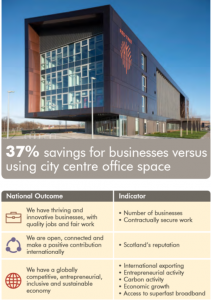National Performance Framework
More than pounds and pence: A national framework for valuing Scotland’s land
July 22, 2020 by Lesley Thomson No Comments | Category making the NPF real
The Scottish Land Commission recently published guidance which places wellbeing at the heart of developing vacant or derelict land. In this post, Kathie Pollard, Policy Officer at the Commission, explains the thinking behind the guidance.
“Getting the measure right is crucially important. If we measure the wrong thing, we will do the wrong thing. If our measures tell us everything is fine when it really isn’t, we will be complacent.” Economist Joseph Stiglitz
Organisations and governments around the world are rethinking how they measure economic success to include social progress as well as productivity.
In Scotland, our National Performance Framework (NPF) offers a practical way for agencies to work together to deliver on a set of National Outcomes that paint a much wider picture of what success means for Scotland. The NPF offers an ideal framework for considering the wider social benefits of reusing vacant and derelict land.
The Scottish Land Commission’s report and framework ‘Guidance on Assessing the Full Economic Benefits of the Productive Reuse of Land’, prepared by Biggar Economics, proposes a framework that places wellbeing at the centre of decision-making processes. It suggests using Scotland’s National Outcomes to help make a business case for regeneration projects.
Why do we need a new approach?
Established in 2017 as a result of the Land Reform (2016) Act, the Land Commission’s vision is a fair, inclusive and productive system of ownership, management and use of land that delivers greater benefit for all the people of Scotland. The way in which land is owned, used, and managed matters hugely if we want to create a successful Scotland. The very nature of land reform brings into focus Scotland’s National Outcomes, which are embedded in our strategic plan: ‘Making More of Scotland’s Land’.

Wishawhill Wood Pumptrack
One of our aims is to transform Scotland’s approach to vacant and derelict land. We currently have 11,000 hectares recorded on the national register – that’s around twice the size of Dundee.
Bringing derelict urban sites back into use could provide new homes, space for growing food in towns and cities, greenspaces for people to enjoy the outdoors and an opportunity to improve biodiversity in urban areas. Some sites may even have the potential to generate renewable energy.
However, many of these sites sit in areas with the greatest poverty and deprivation, with weak prospects for generating reuse. Low land values can mean that owners wait in hope of a better future return. The sites then become ‘stuck’. Anticipated financial returns to the owner are usually the most important consideration. When these numbers don’t stack up, nothing happens. How can we progress if our measures are based on narrow financial returns?
Opportunities to bring sites into productive use need to be looked at in the broader economic, social, and environmental sense. We propose a new approach that applies measures wide enough to capture a range of benefits. This is where the National Performance Framework comes in.
How does it work?

Red Tree Magenta, Shawfield
The new guidance describes how the benefits of these regeneration projects can be identified and, where possible, quantified, using the National Performance Framework. Some of these benefits will be quantifiable while others can be described qualitatively.
National Outcomes as a driver
The NPF provides a logical starting point when looking at how a land reuse project could benefit a local area or community and can be applied at a site level. A focus on Scotland’s National Outcomes encourages greater collaboration and a long-term, holistic view of the potential of places.
Faced with global challenges such as the pandemic and climate change, the Land Commission believes that a similar approach should be extended to all decisions about land use, recognising the importance of land and its management to the health, wealth and overall wellbeing of the population.
Where can I find out more?
The Scottish Land Commission has developed:
- a case for change for decision-makers and funders wanting to move beyond traditional approaches that focus on financial returns;
- practical guidance for those at an operational level, undertaking project appraisals;
- and a series of case studies on the reuse of vacant and derelict land, describing the outcomes and indicators they each support.
The Vacant and Derelict Land Taskforce was set up to reimagine the way in which Scotland addresses this challenge and to substantially reduce the amount of long-term vacant and derelict land in Scotland.
Tags: land use, public bodies, stories, wellbeing

Leave a comment